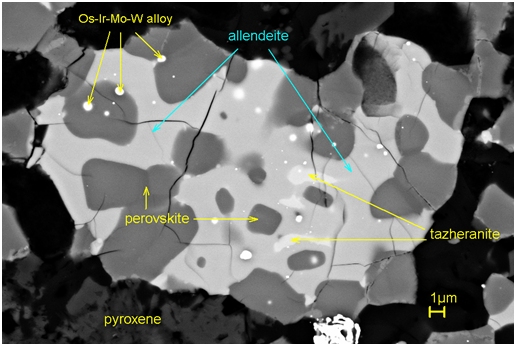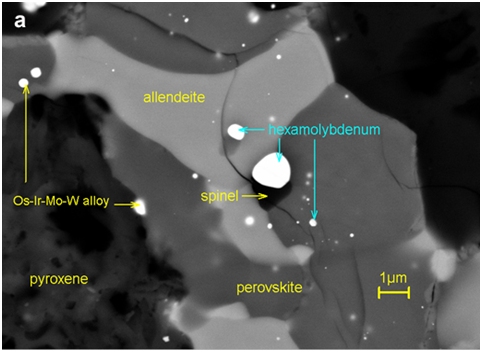
Enlarged BSE image showing a single crystal of allendeite with included perovskite, tazheranite (Zr,Ti,Ca)O2, and Os-,
During a nanomineralogy investigation of the Allende meteorite with analytical scanning electron microscopy, two new minerals were discovered, which occur as micro- to nano-crystals, in an ultrarefractory inclusion ACM-1. They are allendeite, Sc4Zr3O12, a new Sc- and Zr-rich oxide; and hexamolybdenum, (Mo,Ru,Fe,Ir,Os), a Mo-dominant alloy. Allendeite is trigonal, R 3, a= 9.396 Å, c = 8.720 Å, V = 666.7 Å3, and Z = 3, with a calculated density of 4.84 g/cm3 via the structure and our observed chemistry. The name allendeite is for the Allende meteorite that fell in 1969 near the Pueblito de Allende, Chihuahua, Mexico. Hexamolybdenum is hexagonal, P63/mmc, a= 2.7506 Å, c = 4.4318 Å, V = 29.04 Å3 and Z = 2, with a calculated density of 11.90 g/cm3 via the structure and our observed chemistry. The name hexamolybdenum refers to the symmetry (primitive hexagonal) and composition (Mo-rich). The two minerals reflect conditions during early stages of the formation of the solar system. Allendeite, which may have been an important ultrarefractory carrier phase linking Zr-, Sc- oxides and the more common Sc-, Zr-enriched pyroxenes in CAIs, hosts perovskite, spinel, Os-Ir-W-Mo alloys, and hexamolybdenum. Up to ~20% of the Ti may be trivalent, potentially making allendeite an important indicator of redox conditions during very early, high-temperature condensation or the extreme endpoint of volatilization in the primitive solar nebula. The observation of two structurally and chemically distinct highly refractory, low-Pt alloy minerals not associated with Fe-Ni alloys provides the first direct physical evidence for at least two separate carriers of the highly refractory metals in CAIs. Hexamolybdenum thus supplies a missing link between Os-rich and Pt-rich meteoritic alloys and may be a precursor of the latter.

